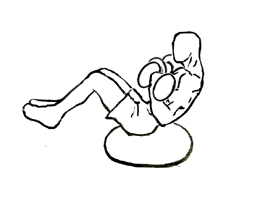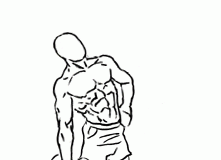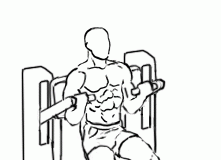Last Updated on October 4, 2024
When it comes to building upper body strength, the biceps curl is one of the most iconic exercises out there. It’s simple, effective, and helps to sculpt and define those coveted biceps. But what if you could take this classic move and ramp it up a notch by adding a core-strengthening element that simultaneously challenges your balance and stability? Enter the Biceps Curl V Sit on Dome with Dumbbells, a full-body exercise that targets your biceps and engages your core like never before.
In this blog, we’ll walk you through everything you need to know about this exercise, from the steps to perform it correctly to the benefits it offers, and some crucial tips to ensure you’re doing it right. Whether you’re a seasoned fitness enthusiast or a beginner looking to try something new, incorporating this exercise into your routine will help you build strength, stability, and muscular endurance.
What Is the Biceps Curl V Sit on Dome?
The Biceps Curl V Sit on Dome with Dumbbells is a variation of the traditional biceps curl, but with an added twist—literally. Instead of performing the exercise while standing or sitting on a bench, you’ll be sitting on a Bosu ball or dome trainer. This unstable surface forces you to engage your core muscles throughout the entire movement, creating a full-body workout that targets not just your biceps but also your abs, lower back, and legs.
The “V sit” component of the exercise comes from the position your body assumes during the movement. As you sit on the dome, your legs will be raised off the ground, forming a “V” shape with your torso. This position further engages your core muscles, challenging your balance and stability as you curl the dumbbells up towards your shoulders.
Muscles Worked
This exercise is a multi-joint movement that engages several muscle groups simultaneously. Here are the primary muscles that benefit from the Biceps Curl V Sit on Dome:
- Biceps Brachii (Biceps):
The primary muscle targeted in this exercise is, of course, the biceps. Every time you curl the dumbbells, your biceps contract to lift the weight. Over time, this repetitive contraction helps to build size, strength, and definition in your arms. - Abdominals (Core):
Sitting on the dome forces you to engage your core muscles to maintain balance and stability throughout the exercise. The V sit position activates your rectus abdominis (the “six-pack” muscles) and the deeper transverse abdominis, helping you build core strength and stability. - Erector Spinae (Lower Back):
To keep your torso upright and prevent you from falling backward, your lower back muscles (erector spinae) have to work hard. This helps improve your posture and strengthen your lower back muscles. - Hip Flexors:
In the V sit position, your hip flexors play a key role in keeping your legs elevated and preventing them from dropping. This engagement helps to strengthen your hip flexors, which are important for movements like running, jumping, and squatting. - Quadriceps and Hamstrings:
Although your legs remain stationary during the exercise, your quadriceps and hamstrings still engage to stabilize your body. This adds an element of lower-body activation that you wouldn’t get from a traditional biceps curl.
How to Perform the Biceps Curl V Sit on Dome
Now that you know the muscles involved, let’s dive into the step-by-step instructions for performing the Biceps Curl V Sit on Dome with Dumbbells. Here’s how to do it properly:
Step 1: Set Up
Begin by sitting on the rounded side of a Bosu ball or dome trainer with a dumbbell in each hand. Make sure you’re sitting right in the center of the dome for maximum stability. Your feet should be flat on the floor at this point, and your knees bent.
Step 2: Get Into the V Sit Position
Once you’re seated comfortably, engage your core by drawing your belly button towards your spine. Slowly lift your feet off the ground and extend your legs out in front of you while keeping your knees slightly bent. Your body should form a “V” shape, with your torso leaning slightly back and your legs elevated off the floor. Balance yourself in this position using your core and lower back muscles.
Step 3: Start the Curl
With your arms extended down by your sides, palms facing forward, begin the biceps curl by contracting your biceps and bending your elbows. Lift the dumbbells towards your shoulders in a controlled motion, keeping your elbows close to your body.
Step 4: Maintain Balance
As you curl the weights, focus on maintaining your balance on the dome. Keep your core engaged throughout the movement to prevent yourself from tipping forward or backward. Avoid using momentum to lift the weights—let your biceps do the work.
Step 5: Lower the Weights
Once you’ve curled the dumbbells up towards your shoulders, slowly lower them back down to the starting position with your arms fully extended. Be mindful of maintaining control during the descent to maximize muscle engagement.
Step 6: Repeat
Complete the desired number of repetitions while keeping your core tight and your body in the V sit position. After finishing your set, carefully lower your legs back to the floor before standing up.
Pro Tips for Success
As simple as this exercise may seem, maintaining proper form and technique is essential to prevent injury and get the most out of your workout. Here are a few pro tips to help you master the Biceps Curl V Sit on Dome:
- Choose the Right Weight:
Start with a light pair of dumbbells, especially if you’re new to this exercise. The added challenge of balancing on the dome can make the movement feel more difficult than a regular biceps curl, so it’s important to choose a weight that allows you to maintain proper form throughout the exercise. - Focus on Your Core:
Your core is key to staying balanced during this exercise. Be sure to engage your abdominal muscles throughout the movement by pulling your belly button in towards your spine. This will help you stay stable on the dome and prevent you from tipping over. - Keep Your Back Straight:
It’s common to round your back or hunch your shoulders when performing this exercise, especially as you start to fatigue. However, it’s important to keep your back straight and your shoulders pulled back to maintain good posture and avoid strain on your lower back. - Control the Movement:
Avoid using momentum to swing the weights up towards your shoulders. Instead, focus on using a slow, controlled motion to lift and lower the dumbbells. This will maximize the effectiveness of the exercise and help you build strength more efficiently. - Breathe:
It’s easy to forget to breathe when you’re focused on balancing and lifting weights, but proper breathing is crucial for maintaining stability. Inhale as you lower the weights and exhale as you curl them up towards your shoulders.
Benefits of the Biceps Curl V Sit on Dome
The Biceps Curl V Sit on Dome with Dumbbells is an incredibly effective exercise that offers a wide range of benefits for your body. Here are some of the top reasons to incorporate this move into your workout routine:
- Full-Body Engagement:
Unlike traditional biceps curls that primarily target your arms, this variation engages multiple muscle groups throughout your body. Not only will you be working your biceps, but you’ll also be strengthening your core, lower back, and legs. - Improved Balance and Stability:
Balancing on the dome forces your body to work harder to maintain stability, which helps to improve your balance and coordination over time. This is especially beneficial for athletes and anyone looking to enhance their overall functional fitness. - Core Strengthening:
The V sit position is a core-centric movement that challenges your abdominal muscles to stay engaged throughout the exercise. This can help to improve your core strength and stability, which is essential for a wide range of everyday activities and athletic movements. - Posture Improvement:
By engaging your core and lower back muscles, this exercise can help to improve your posture. Over time, strengthening these muscles can help to prevent slouching and reduce the risk of developing back pain or other posture-related issues. - Increased Muscle Endurance:
Because this exercise requires you to maintain balance and control throughout the movement, it helps to build muscular endurance. This can translate to improved performance in other exercises and physical activities.
Common Mistakes to Avoid
As with any exercise, there are a few common mistakes that can compromise your form and reduce the effectiveness of the Biceps Curl V Sit on Dome. Here are some pitfalls to watch out for:
- Arching Your Back:
It’s important to keep your back straight and avoid arching or rounding your spine during the exercise. Arching your back can place unnecessary strain on your lower back and increase the risk of injury. - Letting Your Legs Drop:
One of the key challenges of this exercise is maintaining the V sit position throughout the movement. If you let your legs drop or touch the floor, you’re missing out on the core-strengthening benefits of the exercise. Keep your legs elevated and your core engaged to get the most out of the movement. - Using Too Much Weight:
While it may be tempting to grab a heavier pair of dumbbells, it’s important to prioritize form over weight. Using too much weight can cause you to lose balance or rely on momentum to lift the dumbbells, which reduces the effectiveness of the exercise and increases the risk of injury. - Neglecting the Core:
If you’re not engaging your core muscles, you’re missing out on one of the main benefits of this exercise. The Biceps Curl V Sit on Dome is not just about working your biceps—it’s a core-centric movement. Failing to properly engage your core will not only diminish the effectiveness of the exercise but also increase the likelihood of losing your balance. Always focus on keeping your abs tight and your torso stable to fully activate your core muscles. - Rushing Through Reps:
Speeding through the exercise might seem like a way to get more reps in, but it sacrifices quality for quantity. Rushing often leads to poor form, which can result in injury and reduced muscle engagement. Focus on slow, controlled movements to maximize your results and ensure proper form throughout each repetition. - Modifications and Variations
One of the great things about the Biceps Curl V Sit on Dome is that it can be modified to suit different fitness levels and goals. Whether you’re a beginner or a seasoned athlete, there are plenty of ways to adjust the difficulty of this exercise to keep challenging your body as you progress. - For Beginners:
If you’re new to this exercise or struggling to maintain balance on the dome, try these beginner-friendly modifications to make the movement more accessible: - Keep One Foot on the Ground:
If the full V sit position feels too challenging, you can modify the exercise by keeping one foot on the ground while lifting the other leg. This will provide additional stability while still challenging your core and biceps. - Use a Stability Ball Instead of a Dome:
For a slightly easier variation, try using a stability ball instead of a dome trainer. The larger surface area of the stability ball provides more support, making it easier to maintain balance while performing the exercise. - Perform the Exercise Without Weights:
If balancing on the dome is difficult, try performing the V sit without dumbbells to start. Once you’re comfortable holding the V sit position and engaging your core, you can gradually add light dumbbells into the mix. - For Advanced Fitness Enthusiasts:
Once you’ve mastered the basic Biceps Curl V Sit on Dome, you can increase the difficulty by incorporating these advanced variations: - Add a Twist:
To challenge your oblique muscles (the sides of your core), add a twist to the movement. After curling the dumbbells towards your shoulders, rotate your torso to one side before lowering the weights back down. Alternate sides with each repetition. - Perform Alternating Curls:
Instead of curling both dumbbells at the same time, try alternating between your left and right arms. This variation increases the challenge to your core as you work to maintain balance with one arm curling at a time. - Add Leg Movements:
For an even greater challenge, incorporate leg movements into the exercise. As you curl the dumbbells, extend your legs out straight in front of you. As you lower the weights, pull your knees back towards your chest. This dynamic movement will further engage your core and hip flexors. - Incorporating the Biceps Curl V Sit on Dome into Your Workout Routine
Now that you’re familiar with the exercise, you might be wondering how to incorporate it into your workout routine. Here are a few ideas to help you get started: - As Part of an Upper Body Workout:
Since this exercise primarily targets your biceps, it makes an excellent addition to an upper body workout routine. Pair it with other biceps-focused exercises like hammer curls, concentration curls, and chin-ups to create a well-rounded arm workout. - As Part of a Core Circuit:
The Biceps Curl V Sit on Dome is also a great way to work your core. Incorporate it into a core circuit along with exercises like Russian twists, planks, and bicycle crunches to challenge your abs from every angle. - As a Full-Body Finisher:
Because this exercise engages multiple muscle groups, it works well as a finisher at the end of a full-body workout. After completing your main strength training routine, do a few sets of Biceps Curl V Sit on Dome to push your body to the limit and finish your workout strong. - As a Stability and Balance Drill:
If you’re looking to improve your balance and stability, this exercise can be a valuable addition to your routine. Incorporate it into your workout on days when you’re focusing on functional fitness or balance training.
Sample Workout
To give you an idea of how to structure a workout around the Biceps Curl V Sit on Dome, here’s a sample routine that combines upper body strength, core work, and balance training:
Warm-Up:
5 minutes of light cardio (e.g., jogging, jumping jacks, or cycling)
Dynamic stretches focusing on your arms, shoulders, and core
Workout:
Biceps Curl V Sit on Dome with Dumbbells – 3 sets of 12-15 reps
Plank to Shoulder Tap – 3 sets of 30 seconds
Russian Twists – 3 sets of 20 reps (10 per side)
Dumbbell Hammer Curls – 3 sets of 12 reps
Stability Ball Rollouts – 3 sets of 10 reps
Side Plank – 2 sets of 30 seconds per side
Bicycle Crunches – 3 sets of 20 reps (10 per side)
Cool-Down:
5 minutes of static stretching focusing on your arms, shoulders, core, and lower back
This workout provides a full-body challenge that will help you build strength, improve balance, and enhance core stability. As you become more comfortable with the Biceps Curl V Sit on Dome, feel free to increase the weight of the dumbbells or add more sets and reps to continue challenging your body.
The Biceps Curl V Sit on Dome with Dumbbells is a highly effective exercise that not only targets your biceps but also engages your core, lower back, and legs. By incorporating this move into your workout routine, you’ll improve your balance and stability while building upper body strength and muscular endurance.
Whether you’re a beginner or an advanced fitness enthusiast, this exercise can be modified to suit your fitness level and goals. Remember to start with light dumbbells and focus on maintaining proper form and balance. As you progress, challenge yourself with advanced variations to keep pushing your body to new levels of strength and stability.
So next time you’re looking to spice up your biceps workout or add a new core exercise to your routine, give the Biceps Curl V Sit on Dome a try. With consistent practice, you’ll notice improvements in your balance, core strength, and biceps definition. Stay dedicated, and you’ll reap the benefits of this powerful full-body movement!
This blog offers a thorough breakdown of the exercise, its benefits, common mistakes, and variations to suit all fitness levels. The detailed guide will help readers incorporate this dynamic move into their fitness routines effectively.








